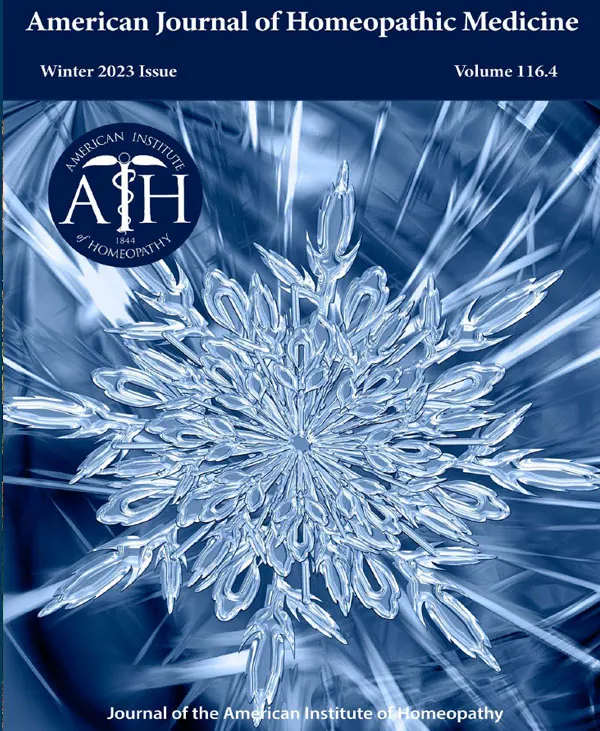
Clinical Snapshot: A COVID-19 Cough
George Guess, MD, DABHM
Abstract: An acute case of SARS-CoV 2 is recorded. The initial influenza-like presentation consisted of chills, arthralgia, pharyngitis and headache was relieved with Phosphorus 30C over the course of five days. Two days later, however, the patient developed a dry cough for which Bryonia 200C was prescribed without effect. Subsequent to the cough changing character and becoming somewhat productive, coupled with additional mild symptomatology indicating some sinus and nasopharyngeal involvement, Kali bichromicum 200C was prescribed, leading to rapid resolution of all symptoms. The knowledge of the close complementary relationship of Phosphorus and Kali bichromicum facilitated the final homeopathic prescription.
Keywords: SARS-CoV2, cough, respiratory infection, Phosphorus, Kali bichromicum
A family of three, all having tested positive for SARS-CoV 2, called me to provide homeopathic treatment for them. No other treatment was being employed, nor was there recourse to ancillary treatment modalities during this patient’s homeopathic treatment. The husband and infant son responded promptly to the first homeopathic medicines prescribed; however the wife, this patient, proved a bit more complicated.
Case Description
The initial presentation of her case consisted of chills, arthralgia, sore throat, throbbing headache in the occiput and temples. The headache was worse bending her body, as well as her head, forward, rising from lying, and weeping. Her throat pain was ameliorated by drinking cold liquids. Anxiety and racing thoughts kept her awake at night. She was very thirsty for cold drinks, preferred company to being alone, and her tongue was coated white in the center.
Phosphorus 30C was prescribed, after which she steadily improved, such that all her symptoms had subsided within five days.
However, two days later, she began to experience cough. The cough was very mild initially, although it made talking difficult. The cough was dry and associated with some chest pressure upon coughing; it was worse from deep breathing, inspiring, talking, walking and bending her head backwards, and ameliorated by drinking and warm, open air. She was also anxious, especially about her mother who also was suffering from COVID-19 and was hospitalized. Her mouth was dry and unimproved by drinking. Touching her throat and/or larynx had no effect. Her energy had improved since the Phosphorus. She noted no dyspnea and her SpO2 was 99 %, as it had been when Phosphorus was prescribed.
At this point, she was prescribed Bryonia 200C, which, unfortunately had no effect.
Three days later, the cough, which had not improved, had changed in character, such that now, rather than dry, it was looser, the expectoration being clear and bubbly, though at times difficult to expel. The cough, while still worse from talking, no longer was aggravated by laughing. Warm, outdoor air helped, enabling her take a deep breath without a spasm of cough; warm drinks helped by making expectoration easier. The cough was generally painless, although the previous evening the cough that arose upon lying down provoked somewhat of a stitching pain deep and to the left of the sternum. Tickling was noted in the throat as phlegm accumulated and provoked coughing.
She was now thirsty for water in sips or hot tea and averse to cold drinks. There was a sensation as of thick mucus in the throat, which was difficult to clear; her right maxillary sinus and the root of her nose felt stuffy and were difficult to clear, worse after having lain in bed at night for a while. She often felt the need to blow her nose without result. Both she in general and her cough were worse on becoming cold. Diarrhea, which she’d had previously, continued, occurring in the morning after waking, driving her out of bed. Stools were dark brown, liquid. Her fatigue, worse upon waking, improved after 11 am only to recur between 3 and 7 pm. She denied anxiety and/or restlessness at this time. Additional symptoms are reflected in the repertorization graph found on the following page (MacRepertory/Complete 2016).
Case Analysis
This final prescription for this illness took some thought. The choice ultimately fell to either Rumex crispus or Kali bichromicum. At the time I found the distinction between the two a bit difficult, both homeopathic medicines sharing traits quite similar to those of this patient: worse from cold air, cough caused by tickling in the throat and aggravated by talking and bending the head backward, and even the diarrhea driving one from bed. When the cough was completely dry—when Bryonia was prescribed—I considered Rumex as a possibility; so, it figured prominently in my mind at this juncture as well. Try as I might, I couldn’t get this patient to affirm that her cough was ameliorated by pulling the bed covers over her head and inhaling warmer air, a strong trait of Rumex crispus. Both medicines can present with scanty, sticky, difficult expectoration, although that particular characteristic tends to be more often associated with Kali bichromicum than the Yellow Dock (Rumex). What ultimately led me toward Kali bichromicum were the newest nasal and sinus symptoms—

stuffiness at the root of the nose and the urge to blow the nose without discharge, as well as a tip shared by George Vithoulkas many years ago when I attended my very first seminar given by him in Athens, Greece.
At that seminar I, as one only very recently introduced to homeopathic medicine, dared to present the case, one of my very first ever, of a woman with Ehlers-Danlos syndrome and a resulting troublesome chronic sinusitis and joint pains, both quite consistent with that diagnosis. As Professor Vithoulkas listened to my presentation it became increasingly apparent to myself and many others that Phosphorus seemed the likely homeopathic medicine as so many of her constitutional characteristics were similar; however the local symptoms—the particulars of the case—possessed some of the characteristics of Kali bichromicum. After George discussed the features of the case, he surmised, quite accurately, that most of us homeopathic neophytes were in favor of Phosphorus; he then went on to thoroughly surprise us all by recommending Kali bichromicum as the needed medicine. He was aware, of course, of a close complementary relationship between the two remedies. He advised that when a case possessed strong Phosphorus elements while simultaneously presenting elements of Kali bichromicum, it was often advisable to consider the latter medicine first as the two were very closely related.
The close association of the two homeopathic medicines is not, I believe, well known as it seems to be underrepresented in many repertories and materia medicas, two exceptions being C.M. Boger’s listing of Phosphorus as a complementary medicine of Kali bichromicum in his Synoptic Key of Materia Medica1 (1931) as well as in his Boenninghausen’s Characteristics: Materia medica & Repertory; there is also a reference to said relationship in the Complete Repertory 20162 under Kali bichromicum, although said relationship does not appear in that repertory under Phosphorus for reasons that escape me.
Below are some Kali bichromicum characteristics as described by Boenninghausen.3
Cough.—Short. On every inspiration, excited by scraping or tickling in air passages, after meals, must hold his sides, with bloody taste in mouth, evening. Rough, hoarse voice. Incessant, from tickling in the trachea and bronchi with a stringy expectoration, or rarer but harder attacks with scanty, white, sweetish expectoration.Expectoration: Of very tough mucus, so viscid it hangs in strings down to feet, difficult to detach, sticky, heavy, lumpy, of reddish mucus, with traces of blood, slate colored, yellow, sweet.
Throat.— . . . thick, gelatinous mucus.
Nose.—Stoppage . . . pressure or pain at root . . .
Complementary: Ars., Phos., Sep., Psor.
So, it was that congruence of the two medicines, Phosphorus, given earlier to this patient with good results for a time, and Kali bichromicum, that clinched the prescription for me.
Prescription: Kali bichromicum 200C, in liquid attenuation, one dose every 6 hours at first; then in decreasing frequency as improvement set in. (10 succussions before each dose).
Result: Having not heard back from the patient for about a week, I emailed her inquiring as to her response to the medicine. She reported that shortly after the very first dose of Kali bichromicum her cough, respiratory symptoms and diarrhea began to abate; the entire ailment subsided completely within three days. This case is yet one more example of the efficacy of homeopathic medicine for viral respiratory ailments, especially, as in this case, those related to COVID-19.
 About the author: George Guess, MD, DHt, practices homeopathy in Charlottesville, Virginia. He is an assistant editor of the “American Journal of Homeopathic Medicine” and Vice-President of the American Board of Homeopathic Medicine. He holds a Diploma in Homeopathy from the Athenian School of Homeopathy
About the author: George Guess, MD, DHt, practices homeopathy in Charlottesville, Virginia. He is an assistant editor of the “American Journal of Homeopathic Medicine” and Vice-President of the American Board of Homeopathic Medicine. He holds a Diploma in Homeopathy from the Athenian School of Homeopathy
References:
- Boger, Cyrus M. ‘Kali bichromicum’. A Synoptic Key of the Materia Medica. Presented by Médi-T (2006) www.homeoint.org/books2/boenchar/mmpetpod.htm#Phos
- Zandvoort, Roger. Complete Repertory 2016. Appearing in Complete Dynamics and MacRepertory repertory software programs.
- Boger, Cyrus M. Boenninghausen’s Characteristics: Materia medica & Repertory. Presented by Médi-T (2006). www.homeoint.org/books2/boenchar/mmhepkal.htm#Kali bi
About the AJHM
The American Journal of Homeopathic Medicine (AJHM) is a peer-reviewed scientific journal, specifically intended to meet the needs of physicians involved in the specialty of homeopathy. The editor invites original manuscripts, feature articles, research reports, 'Homeopathic Grand Rounds' cases studies, abbreviated case reports for 'Clinical Snapshots,' seminar reports, and position papers that focus on homeopathy, as well as book reviews and letters to the editor. Click below to subscribe to the Journal.
Latest Issue of the AJHM

AJHM – Winter 2023
Volume 116 Number 4
Table of Contents
- Editorial: In this Issue
- Homeopathic PuZZle?
- A Case of Erectile Dysfunction and Anejaculation in a Diabetic Patient
- Iron and Its Salts: Materia Medica and Illustration
- Suppression in the Organon
- An Appreciation of Jacques Jouanny’s Life and a Review of His Opus “The Essentials of Homeopathic Therapeutics”


